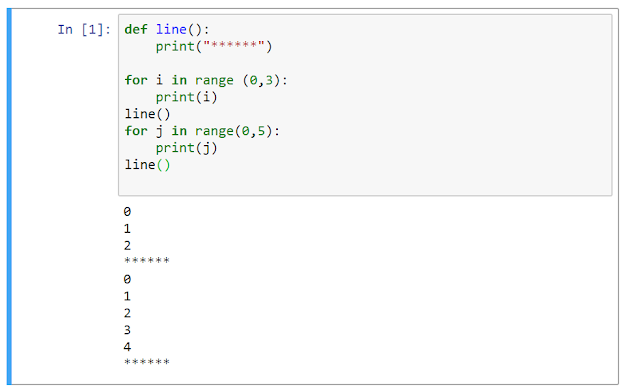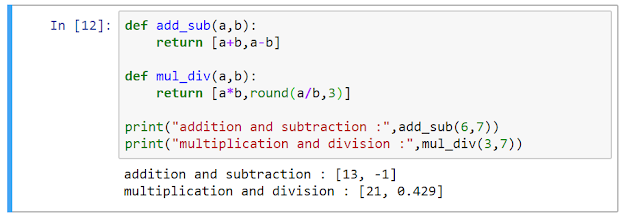Today let us look at how to write the functions in python.
Functions
The functions are code blocks that are executed by calling them. The
functions can be either parameterized or non-parameterized. The syntax for
defining a function is given below. The keyword that specifies that the
block below is a function is def.
def function_name (args) :
statement_1
statement_2
.
.
.
statement_n
return
The blocks need not be wrapped with opening and closing braces. Instead they
have to be maintained in appropriate indentation level like we did when
writing loops.
Non-parameterized functions
These functions do not take up any arguments. The list items supplied to
the functions are called arguments or parameters. These can be used to do a
specific task repeatedly instead placing the piece of code on the program
every time. For example look at the code below.
Here line
is a function which prints a line of '*'. Instead of writing the
print("*******") every time. It can be written once and called
whenever required. This does not require any argument to be passed.
Parameterized functions
These functions require arguments to be passed for processing them and
returning the value. A function can take n number of arguments. While
passing the values, the order of the arguments matter.
In the code snippet given above, the values passed are 7,8 and 9. They are
considered for a,b,c respectively. If you wish to change the order of
arguments then you have to specify the argument variable for which you are
passing the value. For example :
Thus one has to mention the argument explicitly if the order of arguments
will be shuffled while calling. Any kind of instructions can be placed inside function. Statements
for scanning inputs, printing outputs, any arithmetic processing can
be placed inside the functions.
A simple example for parameterized function :
Here you can find the word
return.
'return' keyword
It is the keyword for passing the resultant to the place from where the
function was called. The return statement has to return a single value.
But it can be made to return multiple values by placing the resultants in
a list or tuple. For example:
In the above program I have combined the addition with subtraction and
multiplication with division. Now the function should return the result of
both the operations. I have used a list here to return multiple values.
When printed they are printed as list elements. But if you want them to be
separate and not in a list, then declare n variables where n is number of
return values from the function and call the function like given below.
The returned values will be stored in the variables in the order
returned. Now you can use them separately as required.






Comments
Post a Comment